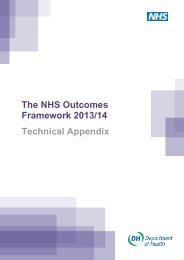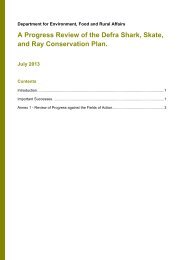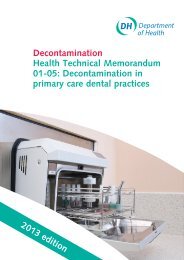A study of Patent Thickets (1.31Mb) - UK Intellectual Property Office
A study of Patent Thickets (1.31Mb) - UK Intellectual Property Office
A study of Patent Thickets (1.31Mb) - UK Intellectual Property Office
Create successful ePaper yourself
Turn your PDF publications into a flip-book with our unique Google optimized e-Paper software.
A Study <strong>of</strong> <strong>Patent</strong> <strong>Thickets</strong> 27<br />
Lei and Wright (2009) find that paradoxically examiners at the USPTO spend more time searching<br />
for prior art on patents that are later rejected at the EPO than on patents that are granted by the<br />
EPO. They argue that this shows that examiners at the USPTO are able to identify weak patents,<br />
but that they may be unable to reject as many as would be socially optimal due to pro-applicant<br />
rules. A problem <strong>of</strong> this “pro-applicant approach,” which presumes patentability <strong>of</strong> an invention,<br />
is that the USPTO has difficulties in rejecting patent applications, which contributes to the patent<br />
quality problem (Allison et al., 2011). Because <strong>of</strong> the quality problems surrounding patents<br />
issued by the USPTO, the FTC has called for more funding to be provided to the patent <strong>of</strong>fice<br />
for the purpose <strong>of</strong> improving patent quality and notice, cf. page 16 in Shapiro (2000), also<br />
Federal Trade Commission, 2011.<br />
Harh<strong>of</strong>f et al. (2012) show empirically that their measure <strong>of</strong> patent thickets has a significant<br />
negative effect on the probability that a patent application is opposed at EPO. They argue that<br />
in a patent thicket the incentive for firms to oppose each other’s patent applications falls as each<br />
new patent overlaps with the patents <strong>of</strong> many other firms and a public goods effect arises when<br />
one <strong>of</strong> these opposes the patent. Additionally, firms may avoid opposing a rival’s patent if they<br />
can expect the rival to retaliate by opposing their own applications. In keeping with this Harh<strong>of</strong>f<br />
et al. (Graevenitz et al., 2012; 2011; Harh<strong>of</strong>f et al., 2012) show that opposition is lowest for firms<br />
at the center <strong>of</strong> patent thickets. This suggests that post-grant opposition cannot be relied upon<br />
to reduce the effects <strong>of</strong> patent thickets on patent quality.<br />
The steep increase in patent filings and their complexity have caused patent <strong>of</strong>fices around the<br />
world to build up large backlogs <strong>of</strong> pending patent applications. Backlogs introduce uncertainty<br />
into patent systems by increasing the length <strong>of</strong> pendency and by exerting additional pressure<br />
on patent <strong>of</strong>fices to process more patent applications with the same amount <strong>of</strong> resources. The<br />
increased uncertainty may affect firms’ filing behaviour directly, but backlogs can also affect<br />
thickets indirectly through the impact they have on the resources available for the examination<br />
<strong>of</strong> patent applications, i.e., the effect on thickets works through the negative impact on patent<br />
quality.<br />
The most recent data for USPTO indicate that there were 536,604 patent applications in 2011<br />
and that there were 690,967 patents awaiting a first action by an examiner. This is down from a<br />
peak <strong>of</strong> 771,529 patents in 2008 (United States <strong>Patent</strong> and Trademark <strong>Office</strong>, 2011). Hegde<br />
(2012) shows that the number <strong>of</strong> pending patents at USPTO has been increasing since 1997<br />
and had quadrupled by 2009. He reports that first-action pendency 20 nearly quadrupled between<br />
1991 and 2010, from 7.6 months to 25.7 months. Meanwhile Quillen et al. (2009) indicate that<br />
a comparison <strong>of</strong> the USPTO application backlog at the end <strong>of</strong> 2008 with the Net Disposal rate<br />
in 2008 yields a 60 month examination backlog. 21<br />
Harh<strong>of</strong>f and Wagner (2009) document that at the European <strong>Patent</strong> <strong>Office</strong> (EPO) the number <strong>of</strong><br />
pending patent cases per examiner increased from 24 in 1978 to 120 in 1998 and that the<br />
average number <strong>of</strong> claims per patent increased from just under 10 to just over 15 in the same<br />
period. The examination period in 1994 lasted on average between 4 years for withdrawn<br />
20 First-action pendency measures the time between filing <strong>of</strong> a patent application and the examiner’s formal<br />
communication <strong>of</strong> a preliminary decision regarding patentability.<br />
21 It should be note that according to USPTO data pendency rates reached a maximum there in 2008 and have<br />
slightly declined since.

















